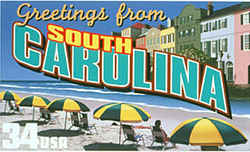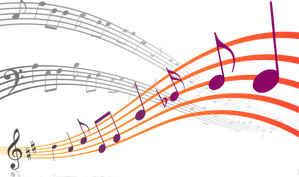
South Carolina Symbols
- 50 States
- » Histories
- » State Symbols
- » Songs
South Carolina State Waltz
"Richardson Waltz"
Music by descendants of General Richard Richardson (1704-1780)
Arranged by Mary S. Richardson Briggs in 1985
Adopted on July 21, 2000.
The "Richardson Waltz" was designated as the official State Waltz by Act No. 389 in 2000. This waltz, a beautiful and soulful melody, is a memento of the musical tradition of the Richardson family, descendants of General Richard Richardson, and has for many generations played an unofficial but important role in the musical history of South Carolina. It was handed down from one family member to another in the family of General Richard Richardson for more than 200 years in Clarendon County.
South Carolina State Waltz: Richardson Waltz
"Richardson Waltz"
According to the bill that introduced "The Richardson Waltz" to the South Carolina Legislature,
"this waltz is a beautiful and soulful melody, is a memento of the musical tradition of the Richardson family, has for many generations played an unofficial but important role in the musical history of South Carolina.
Origin of Song: "Richardson Waltz"
The waltz, known as "The Richardson Waltz", arranged by Mary S. Richardson Briggs, was ratified by the South Carolina Legislature as the official state waltz of South Carolina on June 22, 2000. The Governor signed the legislation on July 21, 2000.
South Carolina Act 389
(A389, R459, H4277)
AN ACT TO AMEND THE CODE OF LAWS OF SOUTH CAROLINA, 1976, BY ADDING SECTIONS 1-1-667 AND 1-1-701 SO AS TO DESIGNATE CERTAIN STATE EMBLEMS OR SYMBOLS.
Be it enacted by the General Assembly of the State of South Carolina:
PART I
Richardson Waltz Act
SECTION 1. Sections 1 through 4 of this act are known and may be cited as the "Richardson Waltz Act".
Findings
SECTION 2. The General Assembly finds that:
(1) The Richardson family, descendants of General Richard Richardson (1704-1780) who came from Virginia as a surveyor to settle in South Carolina,
is known for its great love of music and dancing.
(2) Many balls were held as social entertainment for family and friends from far and wide, and the melody of a favorite waltz for dancing was one which
was "originated" by a family member who played "by ear".
(3) This melody, known as "The Richardson Waltz", still lives today, having been handed down "by ear" from generation to generation but had never been
written until 1985, when it was arranged by Mary S. Richardson Briggs.
(4) Mrs. W. M. Richardson of Orangeburg planted the seed for the preservation of "The Richardson Waltz" many years ago, and Mrs. H. B. Richardson of
Summerton helped hand it down and preserve it for posterity.
(5) This waltz is a beautiful and soulful melody, is a memento of the musical tradition of the Richardson family, has for many generations played an
unofficial but important role in the musical history of South Carolina, and is deserving of designation as the Official State Waltz.
(6) A bill to designate "The Richardson Waltz" as the official waltz was sponsored by Representatives C. Alexander Harvin III, Elsie Rast Stuart, Jimmy
C. Bales, Lynn Seithel, Jackson S. "Seth" Whipper, Becky Meacham-Richardson, Harry L. Ott, Jr., John Milton "Jake" Knotts, Jr., and Walton J. McLeod.
Official state waltz
SECTION 3. Chapter 1, Title 1 of the 1976 Code is amended by adding:
"Section 1-1-667. 'The Richardson Waltz' is designated as the official state waltz."
Distribution by Code Commissioner
SECTION 4. The Code Commissioner shall distribute copies of Part I of this act to any interested persons including the members of the Richardson family
and the Daughters of the American Revolution.
PART II
Carolina Wolf Spider Act
SECTION 5. Sections 5 through 8 of this act are known and may be cited as the "Carolina Wolf Spider Act".
Findings
SECTION 6. The General Assembly finds that:
(1) The state emblems and symbols adopted by the General Assembly and listed in the South Carolina Legislative Manual are an excellent educational
resource for students of this State.
(2) After reading in the Legislative Manual about the existing state symbols and emblems, Skyler B. Hutto, a third grade student at Sheridan Elementary
School in Orangeburg, noted that there was no official state spider and suggested that the Carolina Wolf Spider be given that designation.
(3) A bill to designate the Carolina Wolf Spider as the official state spider was sponsored by Senator Brad Hutto.
(4) Skyler Hutto has worked diligently to pursue this designation for the Carolina Wolf Spider.
(5) His schoolmates and teachers have followed the progress of the legislation with interest.
(6) Through this experience, the students have learned both about spiders and about how a bill becomes a law, which has enhanced the third graders'
study of South Carolina history.
Official state spider
SECTION 7. Chapter 1, Title 1 of the 1976 Code is amended by adding:
"Section 1-1-701. The 'Carolina Wolf Spider', Hogna carolinensis, is designated as the official state spider."
Distribution by Code Commissioner
SECTION 8. The Code Commissioner shall distribute copies of Part II of this act to any interested persons including Skyler B. Hutto and the students
and teachers of the Sheridan Elementary third grade class.
PART III
Time effective
SECTION 9. This act takes effect upon approval by the Governor.
Ratified the 22nd day of June, 2000.
Approved the 21st day of July, 2000.
South Carolina Law
The law designating t "The Richardson Waltz" as the official South Carolina state waltz is found in the South Carolina Code of Laws, Title 1, Chapter 1, Article 9, Section 1-1-667.
TITLE 1. ADMINISTRATION OF THE GOVERNMENT
CHAPTER 1. GENERAL PROVISIONS
ARTICLE 9. STATE EMBLEMS, PLEDGE TO STATE FLAG, OFFICIAL OBSERVANCES
SECTION 1-1-667. OFFICIAL STATE WALTZ
SECTION 1-1-667. Official State waltz. "The Richardson Waltz" is designated as the official state waltz.







